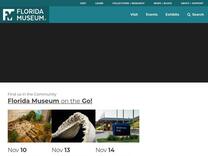‘All Things Beautiful’ Book Launch and Signing – Florida Museum https://www.floridamuseum.ufl.edu/event/all-things-beautiful-book-launch/
Join Florida Museum Director Douglas S. Jones for the launch of All Things Beautiful: Wonders from the Collections of the Florida Museum of Natural History. Lushly illustrated with over 300 color plates, this volume is a celebration of the beauty of natural history collections and the work of curato
remarkable animals, plants, fossils, and cultural heritage materials that make up the 40 million

